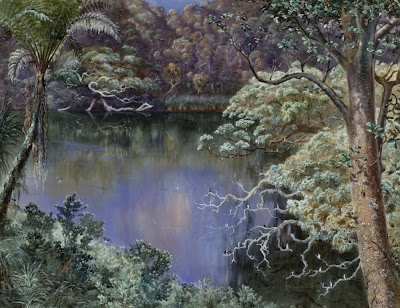This summer the gallery launched an exciting new holiday programme for 6-8 year-olds – Gallery Explorers!
 |
| GET CURIOUS: The intrepid explorers head off into the depths of the Gallery. |
Our sell-out holiday workshops have traditionally been studio-based, and focused around the creation and development of artworks. A key aim in the creation of the new Gallery Explorers programme was to actively engage our younger audience within the walls of the Gallery itself, providing opportunities for them to create meaningful connections between themselves and the original artworks on display.
An excited group of children (led by excitable gallery educators) spent the morning traversing the lengths of the gallery, proudly sporting their official ‘Gallery Explorer’ badges. Original artworks served as starting points for close observation, discussion, game playing and art making. The drama and mystery of Edmund Blair Leighton’s InTime of Peril inspired drawings that imagined ‘what happens next’ in the story. Ideas ranged from the happy (escape, and the consumption of cheese and Marmite sandwiches), to the not so happy (the consumption of the baby via a dragon)...
 |
| GET THINKING: Based on what we can see in this painting, what do you think happens next? Why? |
Jacques Carabain’s Queen Street, Auckland transported the explorers back to 1889, a time before iPads, cell phones and Xboxes - the horror! Gallery educators facilitated a deep exploration of the work, then used children’s responses to create a ‘soundscape’. Children and educators alike filled the gallery with the aural clutter of horses trotting, dogs barking, wind howling, people chatting, sellers selling, and bells chiming! This really brought the painting to life for the children (and for the other visitors who happened to be in the room at the time…Haha).
 |
| GET SHARING: Under Carabain's historic work children shared what they knew about life in the 1800s, and imagined themselves as Victorian children. |
 |
| GET TALKING: Brett Graham's Te Hokioi, 2008, is named after NZ's extinct giant eagle... A predator so large it lived on moa! Now THAT'S a pair of drumsticks!
When it was high time for a wriggle and a giggle the explorers took to the sculpture terrace to play the ‘connections’ game on Jeppe Hein’s Long Modified Bench... Auckland’s future contortionists?
|
At the end of the programme the explorers gathered up all the drawings they had created and bound them into a book to take home. They promised to bring their books back to the Gallery and add to them each time they came to visit. Explorers for life!
Bring on the next school holidays- we can’t wait! Keep an eye on the website for details of upcoming Gallery Explorers sessions.
-Vivien Masters, Gallery Educator



























